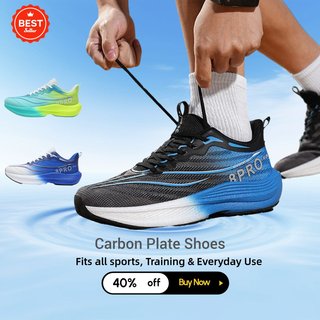Carbon Fiber Shoes: The High-Tech Footwear Revolutionizing Athletics
Wiki Article
In recent years, carbon fiber shoes have made headlines in the world of sports, specifically in long-distance running and competitive athletics. Built with cutting-edge materials and biomechanics in your mind, these footwear are engineered to improve speed, energy efficiency, and overall performance. From Olympic podiums to city marathons, carbon fiber shoes are reshaping how athletes train and compete.
What Are Carbon Fiber Shoes?
Carbon fiber shoes incorporate a carbon fiber plate—a lightweight, rigid component—into the midsole of the shoe. This plate is usually sandwiched within layers of responsive foam to generate a spring-like effect. The carbon plate speeds up energy return, reduce fatigue, and enhance propulsion during toe-off, giving runners a mechanical advantage.

This innovation is frequently paired with advanced foam materials, for example Nike's ZoomX or Adidas' Lightstrike Pro, that are designed to be both lightweight and highly responsive.
Key Benefits of Carbon Fiber Shoes
1. Improved Energy Efficiency
The carbon plate allows you stiffen the shoe, decreasing the energy lost during footstrike and allowing more force being redirected forward. This improves running economy, meaning athletes can conserve a faster pace with less effort.
2. Enhanced Speed and Performance
Studies and real-world results suggest that runners wearing carbon fibre shoes often record faster times. World records in marathon and track events are already broken considering that the introduction of these footwear—most notably with the Nike Vaporfly and Alphafly series.
3. Reduced Muscle Fatigue
By stabilizing the foot and limiting excessive motion, carbon fibre shoes is able to reduce strain on muscles, specifically in the calves and Achilles tendon. This can lead to improved endurance and quicker recovery.
4. Lightweight and Responsive Design
Despite the inclusion of a rigid plate, carbon fibre shoes are remarkably lightweight, leading to a more effortless stride and faster turnover.
Who Uses Carbon Fiber Shoes?
Elite Athletes: Marathoners, triathletes, and track runners in the highest levels often rely on carbon-plated shoes for competitive edge.
Serious Amateurs: Competitive recreational runners seeking personal bests use carbon shoes for races and key workouts.
Everyday Runners: Some use them during training or tempo runs, although their price and durability may limit daily use.
Notable Brands and Models
Several famous labels have released carbon-plated shoes:
Nike Vaporfly / Alphafly
Adidas Adizero Adios Pro
ASICS Metaspeed Sky/Edge
Saucony Endorphin Pro
Hoka Rocket X / Carbon X
New Balance FuelCell SuperComp Elite
Each model offers slight variations in plate stiffness, foam type, and geometry to focus on different running styles.
Controversy and Regulation
The rise of carbon fiber shoes sparked debate over fairness in competition. Critics argued they feature a mechanical advantage comparable to "technological doping." In response, World Athletics introduced regulations limiting sole thickness and requiring shoes to be commercially available for competition use.
Things to Consider Before Buying
Cost: Carbon fiber shoes often retail for $200–$300+.
Durability: Most models are certainly not intended for high-mileage training; expect 150–300 miles of usage.
Fit and Feel: They can feel firmer or even more aggressive than traditional shoes, and might not suit every runner’s biomechanics.
Carbon fiber shoes have undeniably changed the landscape of competitive running. They represent a fusion of materials science, biomechanics, and gratification engineering. Whether you're targeting a podium finish or chasing a personal best, carbon-plated shoes could provide edge you need—provided they suit your training style and goals.